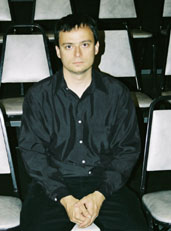
Rusty Banks is a composer/guitarist/teacher originally from Jasper, AL, now living in Pennsylvania.
His compositions benefit from themes relating to regions or environments. For example, his composition commissioned by the Alabama Music Teacher Association's 2004 convention featured audio samples from the Cahaba River, Alabama's last free-flowing river. Another work, "Long Pine Creek: New Year's Day," uses sounds from Long Pine Creek in Nebraska. His compositions range from traditional concert music to sonic installations where boom boxes are scattered throughout a room. His music is described as thoroughly modern, yet accessible, a description he shudders at, but reluctantly accepts. His compositions may be heard on Living Artist Recordings, as well as his web site, rustybanks.org.
|



